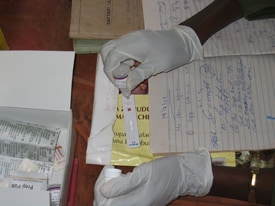Rapid Diagnostic Tests: How They Work
Rapid diagnostic tests (RDTs) most often use a dipstick or cassette format, and provide results in about 20 minutes. A blood specimen collected from the patient is applied to the sample pad on the test card along with certain reagents. Currently approved RDTs for use in the malaria-endemic world can detect 2 types of malaria antigens; one is specific for P. falciparum and the other is found in all 4 human species of malaria. After 15 to 20 minutes (depending on the test), the presence of specific bands in the test card window indicates whether the patient is infected with P. falciparum or one of the other 3 species of human malaria.
RDTs’ Importance in Diagnosis and Treatment in the Malaria-Endemic World
Rapid diagnostic tests (RDTs) offer a useful alternative to microscopy in situations where reliable microscopic diagnosis is not available—or is not available right away. This is the case in most of the malaria-endemic world.

Health worker in Tanzania performing an RDT. (Courtesy S. Patrick Kachur, CDC)
Malaria RDTs are being widely used in malaria-endemic countries, but the use of an RDT does not completely eliminate the need for malaria microscopy.
Because RDTs may not be able to detect some infections with lower numbers of malaria parasites in the patient’s blood and the less common species of malaria, P. ovale and P. malariae, in the malaria-endemic world,
- Patients with negative RDT results can be followed up by microscopy where available to confirm the result.
- Patients with positive RDT results who are not responding to initial antimalarial treatment should be evaluated for other causes of their symptoms to determine whether the treatment was appropriate and to examine parasites in the blood by microscopy to determine the possibility of drug resistance.
Other Considerations
Test Performance and Cost: For RDTs to be optimally useful, the tests must perform well. At this time, product testing has shown that some tests on the market perform much better than others. In addition, care must be taken during transport and storage of RDTs. High temperatures and high humidity in particular can contribute to poor performance. The tests must also be affordable to national malaria programs. The costs of the tests have fallen in the last few years; even so, many malaria control programs find that procuring the large numbers of test kits needed to ensure universal diagnosis is a considerable expense.
Health-Worker Training: New methodologies require training. Health-care workers need training both in the new test methodology, as well as in using the results to treat patients. Available resources can limit the amount and quality of training available under real-world conditions.